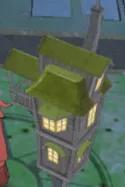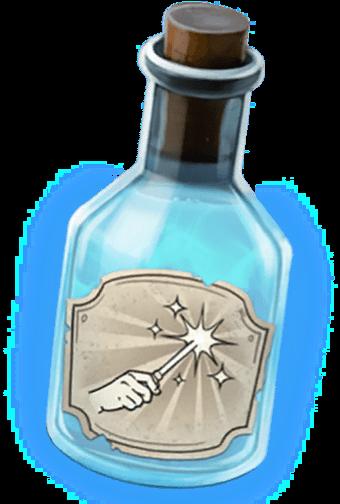The magic wand is, Therefore, a key element in your evolution as a future wizard and its choice should not be made at random. While magic wands are supposed to be able to choose their owner, you will have to in Harry Potter: Wizards Unite create it from A to Z, taking care to properly define each of its component elements.
In order to craft your magic wand, you will need to go to your character icon, located at the bottom left of your screen. All you have to do is click on "No registered wand" to access the different existing wood species as well as the hearts and define a size and flexibility for your future wizard's tool.
The wood of the wand
Each of the four elements to be set plays a major role in how powerful your wand is. However, the wood is, without a doubt, one of the most important parameters, which will have to be chosen and defined with great intelligence. Depending on your date of birth, a species of wood could be greatly favored, allowing your magic wand to be, more or less, powerful.- December 24 - January 20: Birch
- January 21 - February 17: mountain ash
- February 18 - March 17: Ash
- March 18 - April 14: Alder
- April 15 - May 12: Willow
- May 13 - June 9: Hawthorn
- June 10 - July 7: Oak
- July 8 - August 4: Holly
- August 5 - September 1: hazel tree
- September 2 - September 29: vineyard
- September 30 - October 27: Ivy
- October 28 - November 24: Reed
- November 25 - December 23: Elderberry
 Acacia Acacia in English, wood from Africa, America, Australia, South Asia and Western Europe. The acacia wood gives the wands a stubborn character, which makes them refuse to be used by anyone but their master and only agree to give their fullest abilities in the hands of skilled wizards.
Acacia Acacia in English, wood from Africa, America, Australia, South Asia and Western Europe. The acacia wood gives the wands a stubborn character, which makes them refuse to be used by anyone but their master and only agree to give their fullest abilities in the hands of skilled wizards.
 Hawthorn Hawthorn in English, wood from the Northern Hemisphere. Wands made from hawthorn wood can be used for healing spells as well as lethal hexes. Complex in nature, wands made of this essence will be perfect for conflicted wizards going through complicated times.
Hawthorn Hawthorn in English, wood from the Northern Hemisphere. Wands made from hawthorn wood can be used for healing spells as well as lethal hexes. Complex in nature, wands made of this essence will be perfect for conflicted wizards going through complicated times.
 Alder Alder in English, wood from the Northern Hemisphere. The alder wood gives the chopsticks a unique character. While most wands seek profiles with a similar personality to their own, Alder prefers those that will be diametrically opposed. Wands made from alder wood are the most suitable for unspoken spells and suitable for advanced wizards.
Alder Alder in English, wood from the Northern Hemisphere. The alder wood gives the chopsticks a unique character. While most wands seek profiles with a similar personality to their own, Alder prefers those that will be diametrically opposed. Wands made from alder wood are the most suitable for unspoken spells and suitable for advanced wizards.
 Cedar Cedar in English, wood from North Africa, Europe, the Himalayas and the Middle East. Cedar wands are made for shrewd, fair and far-sighted wizards, their owners tending to be gifted with great strength of character and uncommon loyalty, owners whom it is best not to anger especially when attacking beings they love.
Cedar Cedar in English, wood from North Africa, Europe, the Himalayas and the Middle East. Cedar wands are made for shrewd, fair and far-sighted wizards, their owners tending to be gifted with great strength of character and uncommon loyalty, owners whom it is best not to anger especially when attacking beings they love.
 Cherry Cherry in English, wood from Asia and Europe. A particularly rare wood, cherry wood wands are particularly appreciated by Japanese wizards, from the Mahoutokoro school of magic. These wands are strongly recommended for wizards with great self-control and gifted with incredible mental strength. If this essence is coupled with a dragon's ventricle, the wand made from these two elements will possess deadly power.
Cherry Cherry in English, wood from Asia and Europe. A particularly rare wood, cherry wood wands are particularly appreciated by Japanese wizards, from the Mahoutokoro school of magic. These wands are strongly recommended for wizards with great self-control and gifted with incredible mental strength. If this essence is coupled with a dragon's ventricle, the wand made from these two elements will possess deadly power.
 Hornbeam charm in English, wood from the temperate regions of the Northern Hemisphere. Wands made from hornbeam wood are inexorably drawn to sorcerers being inhabited by a unique and pure passion that haunts them. These wands quickly adapt to their owner and quickly assimilate their code of honor, refusing to perform acts that would go against them.
Hornbeam charm in English, wood from the temperate regions of the Northern Hemisphere. Wands made from hornbeam wood are inexorably drawn to sorcerers being inhabited by a unique and pure passion that haunts them. These wands quickly adapt to their owner and quickly assimilate their code of honor, refusing to perform acts that would go against them.
 Chestnut in English, wood available worldwide. The character of a wand crafted from chestnut wood is strongly influenced by that of its owner and therefore prefers wizards with the ability to tame magical creatures and with good botanical or flight skills. However, if the wand is associated with a dragon's ventricle, the latter will tend to favor sorcerers who love material pleasures.
Chestnut in English, wood available worldwide. The character of a wand crafted from chestnut wood is strongly influenced by that of its owner and therefore prefers wizards with the ability to tame magical creatures and with good botanical or flight skills. However, if the wand is associated with a dragon's ventricle, the latter will tend to favor sorcerers who love material pleasures.
 White oak Englishoak in English, wood available in Europe. White oak requires strength, courage and loyalty from its owner. Wands crafted from white oak will be especially appealing to wizards with great intuition and deep connections to nature.
White oak Englishoak in English, wood available in Europe. White oak requires strength, courage and loyalty from its owner. Wands crafted from white oak will be especially appealing to wizards with great intuition and deep connections to nature.
 Red Oak Red Oak in English, wood available in North America. Chopsticks made from red oak wood are ideal for duels. According to the famous wandmaker, Ollivander, red oak wands are worshiped by exceptionally quick-witted, adaptable, delicate, and spell-inventing wizards.
Red Oak Red Oak in English, wood available in North America. Chopsticks made from red oak wood are ideal for duels. According to the famous wandmaker, Ollivander, red oak wands are worshiped by exceptionally quick-witted, adaptable, delicate, and spell-inventing wizards.
 Dogwood Dogwood in English, wood from the temperate regions of the Northern Hemisphere. The dogwood wood will give the wands a character that will make him seek out a wizard who can provide them with countless exciting and fun situations. However, dogwood wands tend to be mischievous and wayward, refusing to perform unspoken spells.
Dogwood Dogwood in English, wood from the temperate regions of the Northern Hemisphere. The dogwood wood will give the wands a character that will make him seek out a wizard who can provide them with countless exciting and fun situations. However, dogwood wands tend to be mischievous and wayward, refusing to perform unspoken spells.
 Cypress Cypress in English, wood from the Northern Hemisphere. Primarily associated with nobility, wands made from cypress are called upon by sorcerers who demonstrate boldness and bravery, unafraid to sacrifice themselves or face their own or others' dark side. A few centuries ago, the lucky owners of cypress wands would regularly die a hero.
Cypress Cypress in English, wood from the Northern Hemisphere. Primarily associated with nobility, wands made from cypress are called upon by sorcerers who demonstrate boldness and bravery, unafraid to sacrifice themselves or face their own or others' dark side. A few centuries ago, the lucky owners of cypress wands would regularly die a hero.
 Ebony Ebony in English, wood from hot and stony mountainous regions. Ebonwood wands are known to be in the hands of individualistic sorcerers, never afraid to be themselves and being impossible to deflect from their goals. They are suitable for all forms of combat magic as well as shapeshifting.
Ebony Ebony in English, wood from hot and stony mountainous regions. Ebonwood wands are known to be in the hands of individualistic sorcerers, never afraid to be themselves and being impossible to deflect from their goals. They are suitable for all forms of combat magic as well as shapeshifting.
 Spruce spruce in English, wood sourced from the Northern Hemisphere. Spruce wood is particularly difficult to work with. Magic wands made from this wood prefer sorcerers who are strong-willed, daring and full of humor and are in no way suitable for cautious or worried people. If the right profile is found, the wand will be able to perform flamboyant and spectacular spells.
Spruce spruce in English, wood sourced from the Northern Hemisphere. Spruce wood is particularly difficult to work with. Magic wands made from this wood prefer sorcerers who are strong-willed, daring and full of humor and are in no way suitable for cautious or worried people. If the right profile is found, the wand will be able to perform flamboyant and spectacular spells.
 Maple Maple in English, wood sourced from North America, East Asia and Europe. Maple wood wands are geared towards sorcerers with the soul of a traveler or explorer. They greatly prefer owners with high ambition, as their magic can become weighty and dull if they cannot find what they are looking for in their master.
Maple Maple in English, wood sourced from North America, East Asia and Europe. Maple wood wands are geared towards sorcerers with the soul of a traveler or explorer. They greatly prefer owners with high ambition, as their magic can become weighty and dull if they cannot find what they are looking for in their master.
 Ash in English, wood from temperate forests. The wands made from ash wood have the important particularity of never having to be given or bequeathed to anyone, otherwise they would lose their magical abilities, something that can be accentuated in the event of the presence of a unicorn's hair in the heart. of the latter. Like ebony wands, ash wands will tend to favor wizards who cannot be deflected from their goals and who are stubborn and courageous, but never arrogant or boorish. For precision, ash wood can also be used to make flying brooms.
Ash in English, wood from temperate forests. The wands made from ash wood have the important particularity of never having to be given or bequeathed to anyone, otherwise they would lose their magical abilities, something that can be accentuated in the event of the presence of a unicorn's hair in the heart. of the latter. Like ebony wands, ash wands will tend to favor wizards who cannot be deflected from their goals and who are stubborn and courageous, but never arrogant or boorish. For precision, ash wood can also be used to make flying brooms.
 Beech Beech in English, wood from America, Asia, Europe and the Forbidden Forest. Wands carved from beech wood are attracted to wizards with great wisdom or understanding of the world, and are by no means effective in the hands of narrow-minded wizards. Beech wood has an excellent reputation for being able to produce magic that is rarely found in other species.
Beech Beech in English, wood from America, Asia, Europe and the Forbidden Forest. Wands carved from beech wood are attracted to wizards with great wisdom or understanding of the world, and are by no means effective in the hands of narrow-minded wizards. Beech wood has an excellent reputation for being able to produce magic that is rarely found in other species.
 Holly Holly in English, wood from North Africa, West Asia and Europe. Endowed with a protective power, the holly wood composing a magic wand will bring a precious help to its owner in his management of anger. This wood is particularly recognized for being absolutely incompatible with the phoenix feather.
Holly Holly in English, wood from North Africa, West Asia and Europe. Endowed with a protective power, the holly wood composing a magic wand will bring a precious help to its owner in his management of anger. This wood is particularly recognized for being absolutely incompatible with the phoenix feather.
 If Yew in English, wood from Great Britain. Yew wood is not the most used in the design of magic wands, the latter being known to endow their master with the power of life and death, more than any other wand. They are generally attracted to out-of-the-ordinary profiles, Tom Riddle's wand having been made from this essence.
If Yew in English, wood from Great Britain. Yew wood is not the most used in the design of magic wands, the latter being known to endow their master with the power of life and death, more than any other wand. They are generally attracted to out-of-the-ordinary profiles, Tom Riddle's wand having been made from this essence.
 Laurier Laurel in English, wood from many parts of the world. Wands made from laurel are particularly energetic and capable of producing powerful, even deadly magic in some cases. They are, however, not attracted by owners endowed with great laziness and have the particularity of throwing a lightning bolt on their own at the sorcerer who would try to steal it.
Laurier Laurel in English, wood from many parts of the world. Wands made from laurel are particularly energetic and capable of producing powerful, even deadly magic in some cases. They are, however, not attracted by owners endowed with great laziness and have the particularity of throwing a lightning bolt on their own at the sorcerer who would try to steal it.
 Larch Larch in English, wood from the temperate regions of the Northern Hemisphere. Larch wood has a reputation for instilling courage and confidence in its masters, prompting many wizards to want to obtain this type of wand. However, these wands are particularly demanding and difficult to control if their master is not up to it, favoring people with hidden talents, who will only take full possession of them when the wand has discovered their considerable talents.
Larch Larch in English, wood from the temperate regions of the Northern Hemisphere. Larch wood has a reputation for instilling courage and confidence in its masters, prompting many wizards to want to obtain this type of wand. However, these wands are particularly demanding and difficult to control if their master is not up to it, favoring people with hidden talents, who will only take full possession of them when the wand has discovered their considerable talents.
 Hazel Hazel in English, wood from the temperate regions of the Northern Hemisphere. Hazel wands are very sensitive and reflect their master's emotional state, which will work much better if the latter is able to control his emotions. In the event of great anger or disappointment from its sorcerer, the wand would be able to capture ambient bad energy and pour it out in unpredictable ways. These wands are utterly devoted to their master and gradually lose their magical potential as the life of its owner fades. For the small precision, the hazel sticks have a unique particularity, since they would have the gift of detecting the presence of underground water, letting out a few small puffs of silvery smoke above a source of water. .
Hazel Hazel in English, wood from the temperate regions of the Northern Hemisphere. Hazel wands are very sensitive and reflect their master's emotional state, which will work much better if the latter is able to control his emotions. In the event of great anger or disappointment from its sorcerer, the wand would be able to capture ambient bad energy and pour it out in unpredictable ways. These wands are utterly devoted to their master and gradually lose their magical potential as the life of its owner fades. For the small precision, the hazel sticks have a unique particularity, since they would have the gift of detecting the presence of underground water, letting out a few small puffs of silvery smoke above a source of water. .
 Walnut in English, wood from the temperate regions of the Northern Hemisphere. Wands crafted from walnut are sensibly attracted to sorcerers of great intelligence and regularly find themselves in the hands of inventors and innovators. Once fully mastered, these wands will be docile, making them a terribly deadly weapon in the hands of a wizard devoid of any shred of morality.
Walnut in English, wood from the temperate regions of the Northern Hemisphere. Wands crafted from walnut are sensibly attracted to sorcerers of great intelligence and regularly find themselves in the hands of inventors and innovators. Once fully mastered, these wands will be docile, making them a terribly deadly weapon in the hands of a wizard devoid of any shred of morality.
 Black walnut Black walnut in English, wood from North America and Europe. Wands crafted in black walnut will seek a master with sure instinct, endowed with great insight and sincerity. It is a wood relatively sensitive to internal conflicts and which will lose a lot of power if its owner is naïve. If the owner of a hickory wand is dishonest, it will most likely no longer work properly, even for enchantments for which it is particularly effective.
Black walnut Black walnut in English, wood from North America and Europe. Wands crafted in black walnut will seek a master with sure instinct, endowed with great insight and sincerity. It is a wood relatively sensitive to internal conflicts and which will lose a lot of power if its owner is naïve. If the owner of a hickory wand is dishonest, it will most likely no longer work properly, even for enchantments for which it is particularly effective.
 Orme Elm in English, wood from North America and Europe. According to ancient beliefs, only pureblood wizards have the ability to produce magic with elm wood wands, although this is completely unfounded. In fact, these wands have a preference for masters with a strong presence, endowed with great magical dexterity and innate dignity. It is also through this wood that the most elegant spells are produced.
Orme Elm in English, wood from North America and Europe. According to ancient beliefs, only pureblood wizards have the ability to produce magic with elm wood wands, although this is completely unfounded. In fact, these wands have a preference for masters with a strong presence, endowed with great magical dexterity and innate dignity. It is also through this wood that the most elegant spells are produced.
 Poplar in English, wood from temperate and cold regions of the Northern Hemisphere. Sticks made from this wood are reliable and offer their master great regularity and power, as long as the latter has a very clear moral vision.
Poplar in English, wood from temperate and cold regions of the Northern Hemisphere. Sticks made from this wood are reliable and offer their master great regularity and power, as long as the latter has a very clear moral vision.
 Pine Pine in English, wood from the Northern Hemisphere. Pine wood wands are for independent, individualistic wizards, who may appear to others to be solitary or inquisitive. These wands particularly appreciate that we show inventiveness when using them and adapt much more easily than other wands to new methods and new spells. Owners of such wands are destined to live much longer than average.
Pine Pine in English, wood from the Northern Hemisphere. Pine wood wands are for independent, individualistic wizards, who may appear to others to be solitary or inquisitive. These wands particularly appreciate that we show inventiveness when using them and adapt much more easily than other wands to new methods and new spells. Owners of such wands are destined to live much longer than average.
 Pear Pear tree in English, wood from all over the world. Pear wood wands have a great preference for benevolent, wise and generous wizards. Their great resistance even gives them the ability to look eternally new, even after very long years of use. According to the famous wandmaker, Garrick Ollivander, lucky owners of pear wands are generally loved and respected by all and sundry, and until now no dark magician has been seen in possession of such a wand.
Pear Pear tree in English, wood from all over the world. Pear wood wands have a great preference for benevolent, wise and generous wizards. Their great resistance even gives them the ability to look eternally new, even after very long years of use. According to the famous wandmaker, Garrick Ollivander, lucky owners of pear wands are generally loved and respected by all and sundry, and until now no dark magician has been seen in possession of such a wand.
 Apple tree in English, wood sourced from the Lovegood House and The Burrow, the Weasley family home. Apple wood, given its more than limited source, is not the wood most used by drumstick makers. However, wands made from this essence are particularly powerful and suitable for wizards with high aspirations. Masters of an apple wand tend to be loving, long-lived, and have a natural gift for conversing with magical creatures in their own language. For information, this type of wood is not very effective for the practice of black magic.
Apple tree in English, wood sourced from the Lovegood House and The Burrow, the Weasley family home. Apple wood, given its more than limited source, is not the wood most used by drumstick makers. However, wands made from this essence are particularly powerful and suitable for wizards with high aspirations. Masters of an apple wand tend to be loving, long-lived, and have a natural gift for conversing with magical creatures in their own language. For information, this type of wood is not very effective for the practice of black magic.
 Blackthorn Blackthorn in English, wood from North America, Europe and Asia. Blackthorn wood is quite unusual in magic. However, the wands made from it are considered to be perfectly suited for warriors. Deep bonds can be forged with their master, if the duo goes through great danger. After such events, wands become loyal and faithful servants.
Blackthorn Blackthorn in English, wood from North America, Europe and Asia. Blackthorn wood is quite unusual in magic. However, the wands made from it are considered to be perfectly suited for warriors. Deep bonds can be forged with their master, if the duo goes through great danger. After such events, wands become loyal and faithful servants.
 Fir tree in English, wood from North America, Asia and Europe. Enduring and determined wizards are likely to be equipped with a fir wood wand. The latter are particularly useful in the exercise of transfiguration and are attracted to wizards endowed with concentration, resolution and able to be intimidating, if the need arises.
Fir tree in English, wood from North America, Asia and Europe. Enduring and determined wizards are likely to be equipped with a fir wood wand. The latter are particularly useful in the exercise of transfiguration and are attracted to wizards endowed with concentration, resolution and able to be intimidating, if the need arises.
 Willow willow in English, wood from all over the world. The use of willow wood in the manufacture of magic wands is uncommon. This wood is endowed with healing powers and is attracted to people experiencing an unjustified feeling of insecurity. Wands crafted from willow usually look good and are effective in casting unspoken spells.
Willow willow in English, wood from all over the world. The use of willow wood in the manufacture of magic wands is uncommon. This wood is endowed with healing powers and is attracted to people experiencing an unjustified feeling of insecurity. Wands crafted from willow usually look good and are effective in casting unspoken spells.
 Sequoia Redwood in English, wood from North America and Asia. Redwood chopsticks are not particularly common, despite their reputation for bringing good luck. These wands are inexorably drawn to wizards who are naturally good at landing on their feet, making the right choices, and taking advantage of disaster.
Sequoia Redwood in English, wood from North America and Asia. Redwood chopsticks are not particularly common, despite their reputation for bringing good luck. These wands are inexorably drawn to wizards who are naturally good at landing on their feet, making the right choices, and taking advantage of disaster.
 Mountain Ash Rowan in English, wood from Europe. The mountain ash is endowed with protective powers superior to other trees. Because of this, protective spells cast from a mountain ash wand are effective and difficult to counter. Rumor has it that, as with the handstand wand, no adept of black magic has been seen in possession of such a wand, the latter being particularly attached to masters with clear minds and hearts. pure.
Mountain Ash Rowan in English, wood from Europe. The mountain ash is endowed with protective powers superior to other trees. Because of this, protective spells cast from a mountain ash wand are effective and difficult to counter. Rumor has it that, as with the handstand wand, no adept of black magic has been seen in possession of such a wand, the latter being particularly attached to masters with clear minds and hearts. pure.
 Elder Elder in English, wood from North America and Europe. Wands made from elderberry wood are very rare and have a reputation for bringing bad luck. Wands made from it are also much more difficult to master than any other wand. They are sensitive and are only attracted to exceptional wizards, loving to feel like beings superior to those around them. The Elder Wand is, moreover, considered to be the most powerful wand ever created.
Elder Elder in English, wood from North America and Europe. Wands made from elderberry wood are very rare and have a reputation for bringing bad luck. Wands made from it are also much more difficult to master than any other wand. They are sensitive and are only attracted to exceptional wizards, loving to feel like beings superior to those around them. The Elder Wand is, moreover, considered to be the most powerful wand ever created.
 Sycamore Sycamore in English, wood from the Forest of Dean, England. Sycamore wood wands are some of the most popular wands in the world of magic. They are mainly attracted by curious wizards, endowed with great vitality and a pronounced taste for adventure. These wands also have the trait of being always in search of new experiences and losing their shine when they are given too simple tasks, even catching fire when they are bored.
Sycamore Sycamore in English, wood from the Forest of Dean, England. Sycamore wood wands are some of the most popular wands in the world of magic. They are mainly attracted by curious wizards, endowed with great vitality and a pronounced taste for adventure. These wands also have the trait of being always in search of new experiences and losing their shine when they are given too simple tasks, even catching fire when they are bored.
 Silverlime silver lime in English, wood sourced from Europe. Wands made from the wood of the silver linden were very popular in the 19th century because of their beauty and their reputation for performing particularly well in the hands of those with the gift of clairvoyance or legilimancy.
Silverlime silver lime in English, wood sourced from Europe. Wands made from the wood of the silver linden were very popular in the 19th century because of their beauty and their reputation for performing particularly well in the hands of those with the gift of clairvoyance or legilimancy.
 Aspen Aspen in English, wood from Asia and Europe. Aspen wands are said to have exceptional bewitching ability and are particularly well suited for martial magic. These wands are for wizards with a strong spirit, revolutionary, determined and more likely than others to embark on a new adventure.
Aspen Aspen in English, wood from Asia and Europe. Aspen wands are said to have exceptional bewitching ability and are particularly well suited for martial magic. These wands are for wizards with a strong spirit, revolutionary, determined and more likely than others to embark on a new adventure.
 Vine Vine in English, wood from all over the world. Vinewood chopsticks are not really common. However, it will seek to be in the hands of a sorcerer with high goals, having an extraordinary perception and being endowed with a deep personality. These wands are capable of producing magical effects the instant a suitable partner enters the room they are in.
Vine Vine in English, wood from all over the world. Vinewood chopsticks are not really common. However, it will seek to be in the hands of a sorcerer with high goals, having an extraordinary perception and being endowed with a deep personality. These wands are capable of producing magical effects the instant a suitable partner enters the room they are in.
The heart of the wand
The heart is the other essential element composing a magic wand, which can greatly affect his power and abilities. The heart of the wands generally comes from magical and legendary creatures, among which we find the unicorn, the phoenix, the troll, the rougarou, the Thestral or the dragon.Of course, some of these hearts are more well-liked than others, by the power they confer, it is therefore not surprising to find mainly dragon ventricles, phoenix feathers or unicorn hair. The last three hearts mentioned are also the only ones present in Harry Potter: Wizards Unite, but nothing indicates that others will not arrive in the future.
 Unicorn hair Unicorn tail hair in English, heart from a unicorn. Unicorn hair generally produces the most stable magical power and is not especially prone to blockages or fluctuations. Magic wands with unicorn hearts are particularly difficult to put to use in the service of the Dark Arts, loyal and remaining greatly attached to their original master, whether it is an accomplished wizard or not. The major disadvantage of unicorn hair lies in the fact that the power they infuse into the wands is limited, in addition to their particularity of falling into melancholy in the event of abuse.
Unicorn hair Unicorn tail hair in English, heart from a unicorn. Unicorn hair generally produces the most stable magical power and is not especially prone to blockages or fluctuations. Magic wands with unicorn hearts are particularly difficult to put to use in the service of the Dark Arts, loyal and remaining greatly attached to their original master, whether it is an accomplished wizard or not. The major disadvantage of unicorn hair lies in the fact that the power they infuse into the wands is limited, in addition to their particularity of falling into melancholy in the event of abuse.
 Phoenix feather in English, heart from a phoenix. The Phoenix Feather is undoubtedly the rarest heart. The latter offers a wide range of magical powers, although it takes much longer to bring out all of her abilities. Endowed with a great capacity for initiative, acting, from time to time, on their own, which may displease many wizards. Magic wands made of a phoenix feather are extremely demanding when choosing their master, because the creatures from which the feathers come are among the most independent and reserved in the world. These wands are generally difficult to master and tame, earning their allegiance through constant hard work.
Phoenix feather in English, heart from a phoenix. The Phoenix Feather is undoubtedly the rarest heart. The latter offers a wide range of magical powers, although it takes much longer to bring out all of her abilities. Endowed with a great capacity for initiative, acting, from time to time, on their own, which may displease many wizards. Magic wands made of a phoenix feather are extremely demanding when choosing their master, because the creatures from which the feathers come are among the most independent and reserved in the world. These wands are generally difficult to master and tame, earning their allegiance through constant hard work.
 Dragon ventricle Dragon heartstring in English, heart coming from a dragon. The dragon ventricle is one of the most used hearts. Generally speaking, dragon ventricles produce much more powerful wands, capable of casting fiery spells. Wands with a ventricle have a much higher learning ability than average. Although they can change allegiance if reclaimed following a victory over their previous master, they still form extremely powerful bonds with their current possessor. Wands whose heart closes a dragon's ventricle tend to turn more easily than others towards the Dark Arts.
Dragon ventricle Dragon heartstring in English, heart coming from a dragon. The dragon ventricle is one of the most used hearts. Generally speaking, dragon ventricles produce much more powerful wands, capable of casting fiery spells. Wands with a ventricle have a much higher learning ability than average. Although they can change allegiance if reclaimed following a victory over their previous master, they still form extremely powerful bonds with their current possessor. Wands whose heart closes a dragon's ventricle tend to turn more easily than others towards the Dark Arts.
Length and flexibility of the wand
Two other elements will influence the capabilities of your magic wand, Namely length and flexibility of the latter. The length of a wand depends greatly on the wizard, since it will be, more or less, proportional to his height. The majority of baguettes measure between 22 and 35 centimeters, however, the longer ones will tend to be drawn to wizards with a strong character and adept at large-scale magic. As it concerns the shortest chopsticks, they will not necessarily be intended for small wizards, since they are strongly attributed to profiles whose personality presents a deficiency.The flexibility of the magic wand will be characterized mainly by his master's ability to adapt and open up to change, which will influence its properties, making it more or less flexible or rigid. If you want more information about Harry Potter: Wizards Unite or join an active community to share pleasant moments with other players, we invite you to join the Harry Potter: Wizards Unite France Community Discord.


























